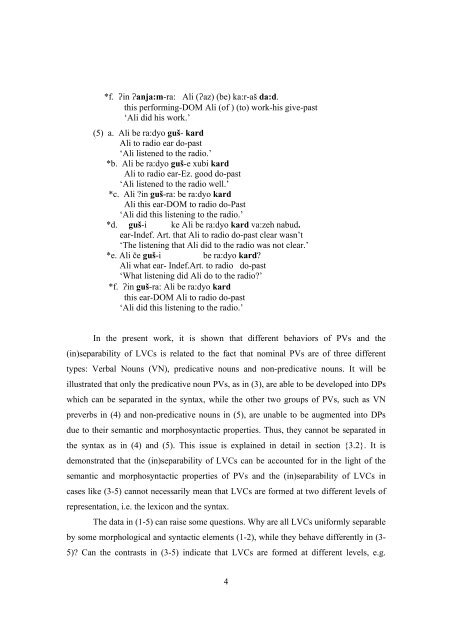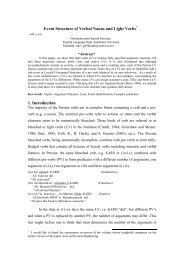Separability of Light Verb Constructions in Persian*
Separability of Light Verb Constructions in Persian*
Separability of Light Verb Constructions in Persian*
You also want an ePaper? Increase the reach of your titles
YUMPU automatically turns print PDFs into web optimized ePapers that Google loves.
*f. ʔ<strong>in</strong> ʔanja:m-ra: Ali (ʔaz) (be) ka:r-aš da:d.<br />
this perform<strong>in</strong>g-DOM Ali (<strong>of</strong> ) (to) work-his give-past<br />
‘Ali did his work.’<br />
(5) a. Ali be ra:dyo guš- kard<br />
Ali to radio ear do-past<br />
‘Ali listened to the radio.’<br />
*b. Ali be ra:dyo guš-e xubi kard<br />
Ali to radio ear-Ez. good do-past<br />
‘Ali listened to the radio well.’<br />
*c. Ali ?<strong>in</strong> guš-ra: be ra:dyo kard<br />
Ali this ear-DOM to radio do-Past<br />
‘Ali did this listen<strong>in</strong>g to the radio.’<br />
*d. guš-i ke Ali be ra:dyo kard va:zeh nabud.<br />
ear-Indef. Art. that Ali to radio do-past clear wasn’t<br />
‘The listen<strong>in</strong>g that Ali did to the radio was not clear.’<br />
*e. Ali če guš-i be ra:dyo kard?<br />
Ali what ear- Indef.Art. to radio do-past<br />
‘What listen<strong>in</strong>g did Ali do to the radio?’<br />
*f. ʔ<strong>in</strong> guš-ra: Ali be ra:dyo kard<br />
this ear-DOM Ali to radio do-past<br />
‘Ali did this listen<strong>in</strong>g to the radio.’<br />
In the present work, it is shown that different behaviors <strong>of</strong> PVs and the<br />
(<strong>in</strong>)separability <strong>of</strong> LVCs is related to the fact that nom<strong>in</strong>al PVs are <strong>of</strong> three different<br />
types: <strong>Verb</strong>al Nouns (VN), predicative nouns and non-predicative nouns. It will be<br />
illustrated that only the predicative noun PVs, as <strong>in</strong> (3), are able to be developed <strong>in</strong>to DPs<br />
which can be separated <strong>in</strong> the syntax, while the other two groups <strong>of</strong> PVs, such as VN<br />
preverbs <strong>in</strong> (4) and non-predicative nouns <strong>in</strong> (5), are unable to be augmented <strong>in</strong>to DPs<br />
due to their semantic and morphosyntactic properties. Thus, they cannot be separated <strong>in</strong><br />
the syntax as <strong>in</strong> (4) and (5). This issue is expla<strong>in</strong>ed <strong>in</strong> detail <strong>in</strong> section {3.2}. It is<br />
demonstrated that the (<strong>in</strong>)separability <strong>of</strong> LVCs can be accounted for <strong>in</strong> the light <strong>of</strong> the<br />
semantic and morphosyntactic properties <strong>of</strong> PVs and the (<strong>in</strong>)separability <strong>of</strong> LVCs <strong>in</strong><br />
cases like (3-5) cannot necessarily mean that LVCs are formed at two different levels <strong>of</strong><br />
representation, i.e. the lexicon and the syntax.<br />
The data <strong>in</strong> (1-5) can raise some questions. Why are all LVCs uniformly separable<br />
by some morphological and syntactic elements (1-2), while they behave differently <strong>in</strong> (3-<br />
5)? Can the contrasts <strong>in</strong> (3-5) <strong>in</strong>dicate that LVCs are formed at different levels, e.g.<br />
4



